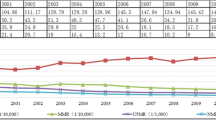Abstract
Objective
To provide tribe- specific child mortality rates and health indicators from selected states in India.
Methods
We used Census 2011 data and Coale Demney methodology to estimate the infant mortality rate (IMR), under-five mortality rate (U5MR) and expectation of life at birth (LEB) for 123 tribes of selected states of India.
Results
The estimated IMR and U5MR were higher in scheduled tribe population compared to respective state’s total population. The IMR varied from 124 in the Birhore tribe of Chhattisgarh and Jharkhand, and the Bharias of Madhya Pradesh to 48 per 1000 live births in the Gamit tribe of Maharashtra. Similarly, the U5MR varied from the highest (203) in the Birhore tribe of Chhattisgarh to the lowest (57/1000 live births) in the Gamit tribe. The LEB varied from 72 years in the Gamit tribe of Maharashtra to 51 years in the Birhore tribe of Chhattisgarh. The study reveals that tribes have gross variation in child mortality rates and there is pressing need to prioritize tribe-specific action plans to improve their health indicators.
Similar content being viewed by others
References
International Institute for Population Sciences. National family Health survey (NFHS-4), India 2015–16. International Institute for Population Sciences. Accessed March 30, 2020. Available from: http://rchiips.org/NFHS/NFHS-4Reports/India.pdf
Anderson I, Robson B, Connolly M, et al. Indigenous and tribal people’s health. Lancet. 2016;388:131–57.
Bisai S, Saha KB, Sharma RK, Muniyandi M, Singh N. An overview of tribal population in India. Tribal Health Bulletin. 2014;20:1–126.
Verma A, Saha KB. Infant mortality among scheduled tribes in Central India: A concern. Indian Pediatr. 2016;53:1117.
Census of India, 2011. Fertility tables (F1 and F5). New Delhi: Office of the Registrar General and Census Commissioner. Accessed February 16, 2020. Available from: https://censusindia.gov.in/2011census/population_enumeration.html
United Nations. Manual X Indirect Techniques for Demographic Estimation, 1983 Population Studies, No. 81. New York: United Nations, Department of International Economic and Social Affairs. Accessed February 17, 2020. Available from: http://www.un.org/en/development/desa/population/publications/pdf/mortality/Manual_X.pdf
United Nations. MORTPAK software version 4.3. United Nations, Department of Economics and Social affairs, Population Division. Accessed February 17, 2020. Available from: http://www.un.org/en/development/desa/population/publications/mortality/mortpak.shtml
Government of India. Tribal health in India-Bridging the gap and a roadmap for the future. Report of the Expert Committee on Tribal Health, 2018. Ministry of Health and Family Welfare and Ministry of Tribal Affairs. Accessed February 17, 2020. Available from: https://nhm.gov.in/New_Updates_2018/NHMComponents/HealthSystem_Stregthening/tribal_health/Tribal-HealthReport.pdf
Saha KB, Saha UC, Sharma RK, Singh N. Indigenous and tribal people’s health. Lancet. 2016; 388:2867.
Sahu D, Nair S, Singh L, Gulati BK, Pandey A. Levels, trends and predictors of infant and child mortality among scheduled tribes in rural India. Indian J Med Res. 2015;141:709–19.
Ghosh R. Child mortality in India: A complex situation. World J Pediatr. 2012;8:11–8.
Pati S, Chauhan AS, Panda M, Swain S, Hussain MA. Neonatal care practices in a tribal community of Odisha, India: A cultural perspective. J Trop Pediatr. 2014;60:238–44.
Sharma RK. Newborn care among tribes of Central India: Experiences from micro level studies. Social Change. 2010:40:117–37.
Acknowledgments
Dr Aparup Das, Director, ICMR-National Institute of Research in Tribal Health, Jabalpur (MP) for his support and guidance. Prof Chander Shekhar, IIPS, Mumbai for his valuable suggestions to improve the quality of the paper.
Author information
Authors and Affiliations
Corresponding author
Additional information
Contributors
AV: Concept and design of study, data compilation and analysis, manuscript writing; RKS: Data analysis, literature review and manuscript writing; KBS: Data interpretation, manuscript writing and final editing. All authors have read final version of the manuscript.
Funding
None
Competing interest
None stated.
Rights and permissions
About this article
Cite this article
Verma, A., Sharma, R.K. & Saha, K.B. Diversity in Child Mortality and Life Expectancy at Birth Among Major Tribes in Selected States of India. Indian Pediatr 58, 20–24 (2021). https://doi.org/10.1007/s13312-021-2090-0
Received:
Revised:
Accepted:
Published:
Issue Date:
DOI: https://doi.org/10.1007/s13312-021-2090-0




